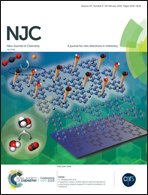Synthesis, characterisation, molecular docking, biomolecular interaction and cytotoxicity studies of novel ruthenium(ii)–arene-2-heteroarylbenzoxazole complexes†
Abstract
In this article, Ru(II)–arene-2-pyridinylbenzoxazole complexes [(η6-p-cymene)RuCl(κ2-N,N-5-bromo-2-(pyridine-2-yl)benzo[d]oxazole)] (4) and [(η6-benzene)RuCl(κ2-N,N-5-bromo-2-(pyridine-2-yl)benzo[d]oxazole)] (5) and Ru(II)–arene-2-quinolylbenzoxazole complexes [(η6-p-cymene)RuCl(κ2-N,N-5-bromo-2-(quinoline-2-yl)benzo[d]oxazole)] (4′) and [(η6-benzene)RuCl(κ2-N,N-5-bromo-2-(quinoline-2-yl)benzo[d]oxazole)] (5′) were synthesized and characterized using various spectroscopic techniques. Structural analysis indicates that the Ru(II) centres are in a distinct mononuclear, one-sided octahedral [RuN6] coordination geometry with two neutral bidentate nitrogen donors in the bromobenzoxazole ligands. All four complexes exhibit three different electronic bands: a sharp band at 300–330 nm due to ligand-to-ligand charge transfer (LLCT); a band around 400 nm due to metal-to-ligand charge transfer; and a small broad peak at around 600 nm due to ligand-to-metal charge transfer. The fluorescence abilities of the four complexes were studied using the LLCT absorption peak as the excitation energy in dimethylsulfoxide: water (1 : 1, v/v), and the quantum yield was found to decrease in the order of 5′ > 4′ > 4 > 5. Density functional theory calculations reveal that the highest-occupied molecular orbital is primarily located on the benzoxazole ring system, while the lowest-unoccupied molecular orbital is mainly located on the Ru atom, which implies possible charge transfer from ligand to metal. The binding strengths of the Ru(II) complexes with DNA (5′ > 4′ > 4 > 5) and bovine serum albumin (4′ > 5′ > 5 > 4) were on the order of 105–106 and 103–105 M−1, respectively. The conductometric data reveal that all four complexes are non-electrolytic in nature, and viscosity decreases in the order of 5′ > 4′ > 4 > 5. This might be due to the effective intercalation of 5′ compared to the other complexes. DNA and protein docking studies suggest that all the complexes interact with DNA through the minor groove and favourably occupy the active sites of proteins based on dipole–dipole interactions. Gel electrophoresis studies show that all complexes degrade plasmid DNA (1 kb) completely within 1 h of exposure time. MTT assay results indicate that all complexes exhibit highly selective cytotoxicity for two cancer cell lines (Caco-2 and HeLa) with respect to normal HEK-293 cells. Among the complexes, 4′ and 5 show the highest cytoselectivities for the Caco-2 and HeLa cell lines, respectively.



 Please wait while we load your content...
Please wait while we load your content...